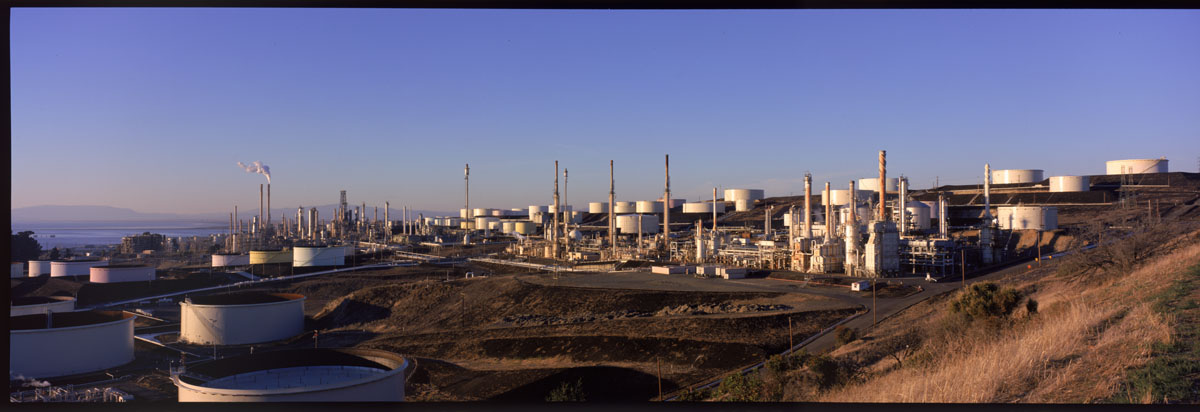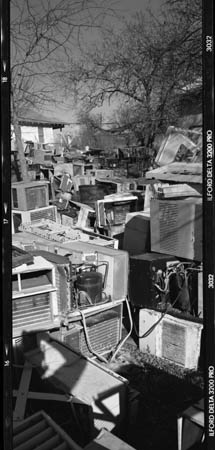


The Fuji 617 is a big box with a 5x7" view camera lens in front and a pressure plate for 120/220 film in back. The angle of view from the 105mm f/8 lens is about the same as a 24mm lens on a Nikon but it is spread across a glorious 6x17 cm (2.25 x 6.5") of film. Load up some Ektar 25 and you can do a wall-size enlargement that will bear close-up scrutiny of any portion.
My number one complaint with this camera is that the focusing helical will only rack the lens far out enough for sharp focus at 3 meters. Thus, one can't do the kind of near-far shots that wide-angle lenses are best suited for. Even stopping the lens down to f/45 only brings objects at 1.9 meters into adequately sharp focus.
Sometimes a helical just isn't a substitute for a bellows.
Framing the picture exactly in the camera-top finder is tricky, especially if you are an eyeglass-wearing geek like myself. Fuji provides some clever mechanical alignment aids and a fluid level, but you still don't quite know what you have until you get back from the lab. I understand why some people get a ground glass for the back so that they can frame their images more precisely. You only get four shots on a roll of 120 so having to open the back to frame every shot isn't a big deal.
Results are incredibly sharp and detailed, however. Velvia looks glorious on a light table and even Fuji 400 negative film looks beautiful in 10x30" proofs. It is very difficult to get this kind of quality out of a view camera because the film is so much thicker and doesn't lie flat in the film holder.
I paid $2200 for mine "virgin used". It showed 5 on the shutter counter on the bottom of the camera, which means that 50 exposures had been made. (The big Fuji cameras have exposure counters because big leaf shutters like these need periodic service.) The price included a center filter, hard case, lens hood, cable release, and manual. I considered it excellent value because the new Fuji (GX-617) with interchangeable lenses costs more than $5000 for the body and a 105/8 lens.
Probably the toughest thing to figure out with the camera is what to do with the output. Magazines can reproduce from the big chromes with no problem. If they scan, they'll use a drum scanner which can handle the big negs or chromes. However, you can't even make prints yourself unless you have a rare 5x7" or 8x10" enlarger. One theoretically nice option is ABC Photo's develop and proof from C41 negative film. They've set up an automated line which keeps the cost per roll including processing to about $36. The 10"x30" proofs are impressive and they'll make machine reprints for $6-10 each depending on quantity. Call them at (703) 369-2566 and let me know how they work for you. I've had mixed results. A promising lab that I haven't tried is run by the folks who import Roundshot camera. Their Web site ( www.roundshot.com) says that they will proof 617 to 4x12" prints for $6 each (so the cost of developing and printing a roll of 120 is about $30). They will make 20x60 reprints for $95 (prices as of November 1998).
Don't plan on putting these images on the Web. Kodak's biggest scanner for making ProPhotoCDs can only handle up to 4x5" chromes. A drum scan will cost you $75. If you are going to go the desktop scan route, you'd probably be better off using a Nikon, 24mm lens, PhotoCD, and cropping.
I'm still trying to figure out the best way to present the 600 MB scans I have
from this camera. But to whet your appetite, here are a couple done in-line...

